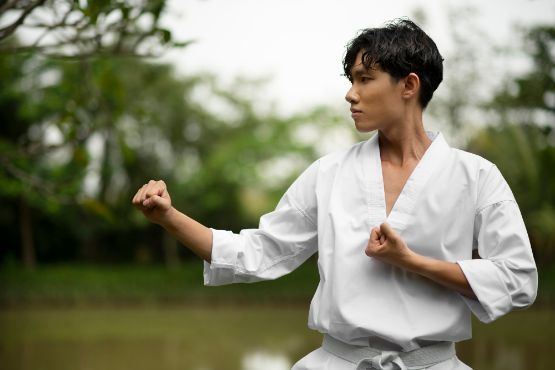Table of Contents Show
Explore the ongoing debate on ‘Do you need a yoga mat for Tai Chi?’ Dive into the benefits of using a mat, the rise of specialized Tai Chi mats, and tips to make the right choice for your practice. Embrace tradition and modernity in harmony.
So, here you are, scrolling through articles while sipping your cup of organic matcha tea, wondering, “Do you need a yoga mat for tai chi?” Ah, life’s perplexing questions. Before we start diving into the mystical world of tai chi, mats, and Amazon deals (oh my!), let’s get one thing straight. The answer isn’t a simple “yes” or “no.” So, buckle up, reader, and let’s go on a mat-ical journey.
Disclosure: As an Amazon Associate I earn from qualifying purchases.
Tai Chi and Yoga: The Spiritual Twins with Different Accents
Tai Chi: A serene dance with the wind, or so it seems. It’s one of those things that, at first glance, might look like an elegant dance of elderly folks in a park. But don’t let that fool you. Hailing from ancient China, tai chi is steeped in centuries of tradition, martial discipline, and philosophy. Often referred to as “meditation in motion,” this practice isn’t about just moving your arms about; it’s about moving with awareness, intention, and controlled breathing.
- Martial Origins: Many might not realize that tai chi actually originated as a martial art. Its slow, deliberate moves were designed for self-defense. It’s all about redirecting or deflecting an attacker’s force against them.
- Health and Harmony: Modern practitioners often turn to tai chi not for its martial application, but for its myriad health benefits. It’s known to enhance muscular strength, flexibility, balance, and, importantly, to reduce stress. The movements, coupled with deep breathing, promote an inner calm and a heightened state of awareness.
- A Spiritual Connection: Much like yoga, tai chi isn’t just about physical movement. It’s deeply spiritual. Rooted in Taoist and Confucian philosophies, it aims to harmonize the yin and yang, the opposing forces within the body.
Yoga: If tai chi is the gentle flow of a river, yoga is the mountain in meditation – steady, poised, and grounding. An ancient Indian practice, yoga has taken the world by storm, and there’s a good reason for that. The term “yoga” comes from the Sanskrit word “yuj,” which means “to yoke” or “bind.” No, it’s not about binding yourself into a pretzel, although some poses might seem that way!
- Beyond the Mat: Yes, there’s a mat involved, but yoga goes far beyond that. It’s a holistic practice that merges the mind, body, and soul. While the western world primarily focuses on the postures (asanas), traditional yoga includes ethical disciplines, breath control (pranayama), sensory withdrawal, meditation, and a quest for enlightenment.
- Healing and Health: Much like tai chi, yoga has a myriad of health benefits. From improving flexibility and strength to reducing stress and anxiety, its effects are profound. Certain styles of yoga, like ‘Yin,’ can even promote joint health.
- A Cultural Phenomenon: Over the past few decades, yoga has transformed from an ancient practice to a global cultural phenomenon. Whether it’s hot yoga, aerial yoga, or goat yoga (yes, it’s a thing), it’s evident that this ancient practice can adapt and evolve.
The Great Mat Debate: A Slippery Slope or a Comfort Haven?
Ah, the mat. An often overlooked but crucial companion in our quest for balance, both in yoga and possibly tai chi. Here’s the twist – while yoga practitioners might consider a mat as essential as air (okay, maybe not that essential), for many tai chi enthusiasts, it’s a bit of a slippery topic.
The Case For The Mat:
- No-Slip Grip: Imagine this – you’re gracefully transitioning between your poses or stances, and whoops! You’re on the floor. Not the elegant move you were hoping for. Mats, especially those with a non-slip texture, can save you from such embarrassing incidents.
- Joint Comfort: Hard surfaces can be brutal on the knees, ankles, and wrists. A mat provides that extra cushioning, ensuring that your body doesn’t bear the brunt of your enthusiasm.
- Defines Your Space: Whether you’re in a class or your living room, a mat defines your space. It’s like telling the world, “This is my sanctuary for the next hour.”
The Case Against The Mat:
- Grounding Connection: Especially relevant for tai chi practitioners who love practicing outdoors. The feel of grass under your feet, connecting with the earth – it’s a sensation a mat can’t replicate.
- Mobility Matters: Tai chi involves a lot of stepping, shifting, and turning. On a mat, this can sometimes feel restrictive. The last thing you want is to trip on your own mat.
- Traditionalists’ Take: Many tai chi purists argue that for an authentic experience, you need to be mat-free. After all, ancient practitioners weren’t popping down to their local sports store for a mat.
However, times are changing. As we’ve seen with products like the Navaris round yoga mat, mats are evolving to cater to a wider range of activities [5]. They’re not just confined to yoga anymore. So, whether you’re Team Mat or not, it’s essential to find what works best for you.
“Do You Need a Yoga Mat for Tai Chi?”: The Rising Popularity of Mats in Traditional Practices
Tai chi and yoga are both time-honored disciplines, deeply rooted in tradition and practice. Yet, the fusion of modernity with these practices leads to one of the most frequently asked questions: “Do you need a yoga mat for tai chi?”
While the purists might balk at the idea, there’s a growing number of enthusiasts who are singing praises for the cushiony embrace of a yoga mat during their tai chi sessions.
Why the Sudden Surge?
- Safety First: The world is embracing health and wellness like never before. And with that, there’s a wave of beginners trying their hands (and feet) at tai chi. For them, the non-slip surface of a yoga mat offers confidence. It’s like a safety net, preventing any unexpected skids.
- Diverse Environments: Not everyone has the luxury of practicing tai chi on grass or wooden floors. Those in urban settings, with concrete terraces or tiled floors, find the cushioning of a yoga mat indispensable.
- Versatility: With platforms like Amazon offering yoga mats that are perfect for various exercises – be it pilates, general fitness, or even tai chi [1], the line between a ‘yoga’ mat and an ‘exercise’ mat is blurring. “Do you need a yoga mat for tai chi?” Well, when that same mat can be used for your HIIT session and your meditation hour, why not?
But Here’s the Other Side of the Coin
For every tai chi practitioner who loves their mat, there’s another who prefers the raw, unfiltered connection with the ground. They argue that the very essence of tai chi is to be in tune with nature and the environment. A mat, in their opinion, acts as a barrier to that connection.
Moreover, traditional tai chi involves a fluidity of movement – gliding, stepping, turning – which might feel restricted on a mat. Remember, tai chi evolved from martial roots. Being grounded and balanced, feeling the earth beneath, was all part of the martial strategy.
Tapping into the Tai Chi Mat Market: The Boom of Specialized Mats
Yes, you heard that right. As the debate rages on about “Do you need a yoga mat for tai chi?”, enterprising businesses are not waiting around. They’ve identified a niche – mats specifically designed for tai chi.
Sites like GreatMats have listings for mats that cater to the unique needs of tai chi practitioners [4]. These aren’t just your run-of-the-mill yoga mats. They’re engineered keeping in mind the flow, the steps, and the turns of tai chi.
What’s Special About These Mats?
- Optimized Grip: These mats balance the need for movement with the need for grip. So, while you won’t find yourself skidding, you won’t feel stuck in one place either.
- Material Matters: They often use materials that mimic more natural surfaces. Take the Woodflex 8 mm Maple Full Roll for example. It provides the look and feel of a wooden floor, ensuring practitioners don’t miss out on that ‘natural’ feel [4].
- Ease of Installation: Many of these mats, like the Premium Martial Arts Mats, are interlocking, making it easy for users to set them up or pack them away [4].
A Caveat: Buyer Beware
While these mats sound like the perfect solution to the “Do you need a yoga mat for tai chi?” conundrum, it’s crucial to do your research. Not all mats are made equal. And what works for one practitioner might not work for another. Always check for reviews, get recommendations, and if possible, try before you buy.
Making the Right Choice for You
At the end of the day, whether you’re practicing tai chi or yoga, it’s a personal journey. What feels right, what resonates with you, is what matters most.
To answer the question, “Do you need a yoga mat for tai chi?” – it’s subjective. Some find the mat an essential companion, while others feel it hampers their connection. If you’re curious, give both ways a shot. After all, both tai chi and yoga are about exploration – not just of the practice, but of oneself.
You May Also Like: Do You Need A Yoga Mat For Zumba? – 4 Essential Ways to Enjoy the Switch!
The Big Question: Do You Need a Yoga Mat for Tai Chi?
Well, Sherlock, do you? It depends:
- Outdoor Fanatic: If you’re practicing outdoors, feel the earth beneath your feet.
- Indoor Enthusiast: On a sleek wooden floor? A mat can be a great addition.
- Tai Chi Stylist: If you’re more of a modern tai chi practitioner who likes to mix it up, why not?
Plus, consider where you’re shopping. If Amazon’s got a great discount, perhaps that’s a sign from the universe? [1] Or maybe you’re feeling fancy and want to browse Etsy for that personalized mat touch.
Conclusion: Finding Your Flow
To sum it all up, while you might not strictly need a mat for tai chi, having one can enhance your experience. Think about it. Your choice of mat can reflect your style, offer comfort, and provide a non-slip surface to ensure your moves are slick and safe. So, whether you’re a mat person or not, the most crucial thing is to find your flow. And maybe save that cup of matcha tea for after your session.
You May Also Like: What is Goat Yoga & Why You Should Try to Unleash your Zen Today! 6 Reasons
Frequently Asked Questions:
Q1. Do I need to buy a specific tai chi mat?
A: Not necessarily. A yoga mat, especially a non-slip one, can work just as well for tai chi.
Q2. I’ve seen tai chi done outdoors. Why would I need a mat?
A: If you practice indoors, a mat can provide comfort and prevent slipping. Outdoors, the natural ground works perfectly.
Q3. What’s the difference between tai chi and yoga in terms of movement?
A: Tai chi involves more fluid, continuous motions, while yoga is more about holding specific postures.
Q4. I found a cute Star Wars yoga mat. Can I use it for tai chi?
A: Absolutely! The Force is strong with tai chi.
Q5. Any particular place to get deals on mats?
A: Amazon often has discounts on yoga mats suitable for tai chi. Check out their site for the latest deals.
You May Also Like: What is Goat Yoga & Why You Should Try to Unleash your Zen Today! 6 Reasons



